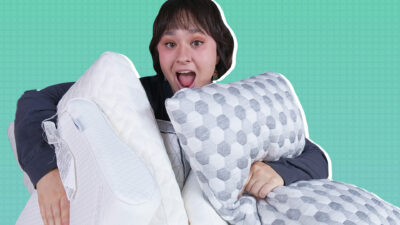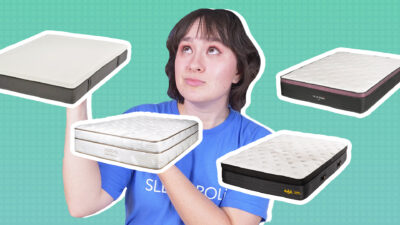Before reading about the best mattresses for lightweight sleepers, you might be wondering what the term “lightweight sleeper” even means. Well, here at Sleepopolis, we classify a lightweight sleeper as anyone who weighs 130 pounds or less. Because these sleepers have a lower body weight than average, they have a different scale when it comes to determining a mattress’s firmness. Typically, all mattresses are going to feel slightly firmer to these sleepers, since they have less body weight that is sinking into the bed and being cushioned by its layers. Because of this, lightweight sleepers have to think a little bit harder about what mattress they’re buying before they take the leap, especially if they are shopping online.
As you might know if you’ve read other Sleepopolis mattress roundups, a sleeper’s mattress decision is hardly ever based on one factor alone. While a lightweight sleeper may be looking for a slightly less firm mattress to make sure they don’t feel like they’re sleeping on a board, they might also want to find a mattress that is great for joint pain, motion transfer, or cooling.
All of the mattresses on this list have gone through multiple tests that determine not only their firmness, but a series of other factors that relate to body type, preferred sleeping position, and whether or not the customer is sleeping with a partner or a pet. This way, you’re not only learning about mattresses that are great for a typical lightweight sleeper — you’re also finding a mattress that’s great for you.
Our Top Pick for Lightweight Sleepers
We chose the DreamCloud as the best mattress for lightweight sleepers because of its versatility. Its multiple layers of soft memory foam and individually wrapped coils conform to the body, making the bed a good match for several different sleeping positions.
The Best Mattresses for Lightweight Sleepers 2024
- Best Overall – DreamCloud
- Best Cooling Mattress for Lightweight Sleepers – WinkBed
- Best Mattress for Lightweight Sleepers with Joint Pain – Helix Sunset
- Best Mattress for Lightweight Couples – Nectar Hybrid
- Best Mattress for Lightweight Stomach Sleepers – Saatva
- Best Hybrid Mattress for Lightweight Sleepers – Brooklyn Bedding Signature Hybrid
- Best Memory Foam Mattress for Lightweight Sleepers – Bear
- Best Flippable Mattress for Lightweight Sleepers – Layla
- Best Mattress for Lightweight Side Sleepers – Puffy Lux Hybrid
- Best Organic Mattress for Lightweight Sleepers – Zenhaven
Compare Best Mattresses for Lightweight Sleepers
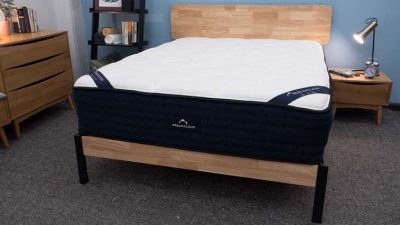

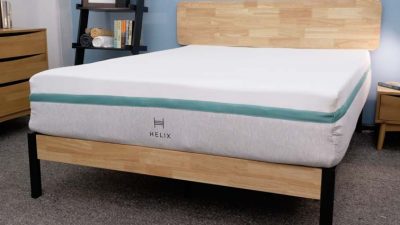
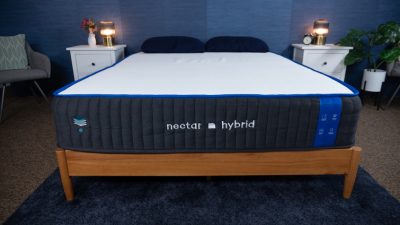
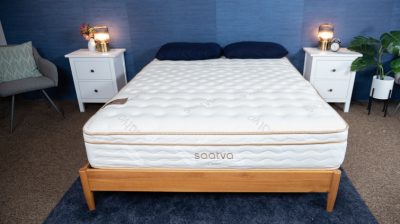
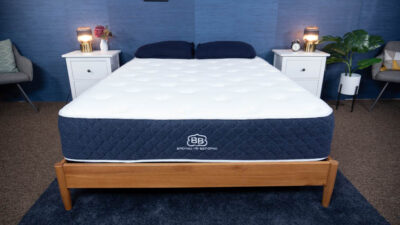
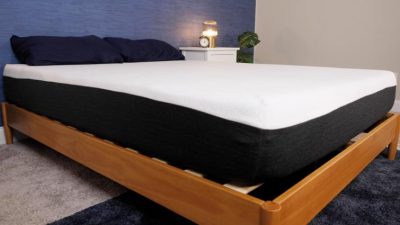
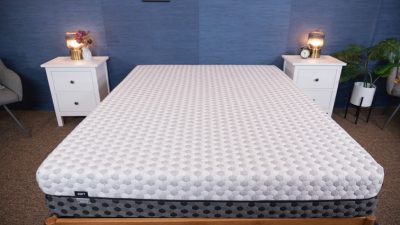
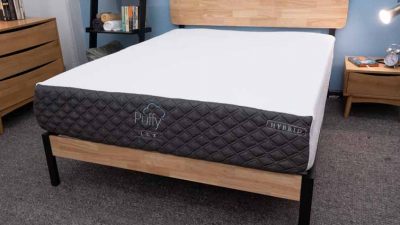
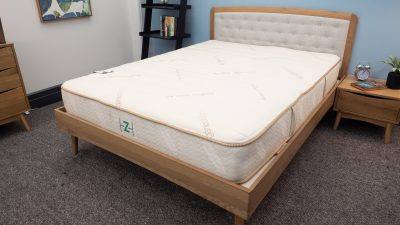
DreamCloud Original Mattress
WinkBed Mattress
Helix Sunset Mattress
Nectar Hybrid Mattress
Saatva Mattress
Brooklyn Bedding Signature Hybrid Mattress
Bear Original Mattress
Layla Mattress
Puffy Lux Hybrid Mattress
Zenhaven Mattress
Rating
Firmness
Firm: 7/10
Multiple firmness options
Soft: 5.5/10
Medium-firm: 6.5/10
Multiple firmness options
Multiple firmness options
Firm: 7.5/10
Multiple firmness options
Soft: 5.5/10
Multiple firmness options
Material
Hybrid
Hybrid
Hybrid
Hybrid
Innerspring
Hybrid
Foam
Foam
Hybrid
Latex
Cooling
✓
✓
--
--
✓
--
✓
✓
✓
✓
Sleep Position
Back
Combination
Back & Side
Back
Back & Stomach
Back
Back & Side
Combination
Back & Side
Back & Side
Best Mattresses for Lightweight Sleepers Video Review
Best Overall – DreamCloud
The DreamCloud Mattress is a luxury hybrid mattress made with layers of memory foam and pocketed coils. It offers a great combination of support and pressure relief that back sleepers will really enjoy.
We recommend this mattress for the following sleeper types: Financing options are available for this mattress. I have purchased 5 different Dreamcloud mattresses over the years and never once disappointed. Always fast shipping. Fantastic pricing. But by far the best feature is the quality of the Dreamcloud mattress. Also very impressed with the free bedding (sheets) that came with my recent two purchases. Don’t change what you are doing/offering. It’s perfect in every way.
The DreamCloud Mattress is a luxury hybrid mattress made with layers of memory foam and pocketed coils. It offers a great combination of support and pressure relief that back sleepers will really enjoy.
We recommend this mattress for the following sleeper types: Financing options are available for this mattress. I have purchased 5 different Dreamcloud mattresses over the years and never once disappointed. Always fast shipping. Fantastic pricing. But by far the best feature is the quality of the Dreamcloud mattress. Also very impressed with the free bedding (sheets) that came with my recent two purchases. Don’t change what you are doing/offering. It’s perfect in every way.
The DreamCloud Mattress is a luxury hybrid mattress made with layers of memory foam and pocketed coils. It offers a great combination of support and pressure relief that back sleepers will really enjoy.
We recommend this mattress for the following sleeper types: Financing options are available for this mattress. I have purchased 5 different Dreamcloud mattresses over the years and never once disappointed. Always fast shipping. Fantastic pricing. But by far the best feature is the quality of the Dreamcloud mattress. Also very impressed with the free bedding (sheets) that came with my recent two purchases. Don’t change what you are doing/offering. It’s perfect in every way.
DreamCloud Original Mattress

Material
Hybrid
Trial Period
365 nights
Shipping Method
Free shipping
Firmness
Firm: 7/10
Warranty
Lifetime warranty
Price Range
$$$$$
Hot Sleepers
If you often overheat while you sleep, this mattress should help you stay cool.
Seniors
This bed is perfect for senior sleepers.
Back Sleeping
Ideal for average weight back sleepers.
Financing Options
DreamCloud Original Mattress

Material
Hybrid
Warranty
Lifetime warranty
Firmness
Firm: 7/10
Shipping Method
Free shipping
Trial Period
365 nights
Price Range
$$$$$
Hot Sleepers
If you often overheat while you sleep, this mattress should help you stay cool.
Seniors
This bed is perfect for senior sleepers.
Back Sleeping
Ideal for average weight back sleepers.
Financing Options

DreamCloud Original Mattress
Material
Hybrid
Firmness
Firm: 7/10
Trial Period
365 nights
Warranty
Lifetime warranty
Shipping Method
Free shipping
Price Range
$$$$$
Hot Sleepers
If you often overheat while you sleep, this mattress should help you stay cool.
Seniors
This bed is perfect for senior sleepers.
Back Sleeping
Ideal for average weight back sleepers.
Financing Options
Expert Opinion
When it came to picking our overall best mattress for lightweight sleepers, the DreamCloud stood out because, for people 130 pounds or less, it works well for the majority of sleeping positions. This is a luxury hybrid mattress, so it includes both coils and foams to combine support and pressure relief. This makes sure that stomach sleepers and back sleepers get the support they need for a neutral spinal alignment, while occasional side sleepers get the cushioning and sinkage they need to alleviate pain around their joints.
What our tester says: “I really like how luxurious this mattress feels and how it could work for a variety of sleepers. Along with that, I found that the breathable cashmere cover helps the DreamCloud sleep cool throughout the night.” – Bridget Chapman, former senior product editor
What Customers Say
Reviews on the DreamCloud website praise this mattress for its ability to get rid of their joint pain, especially in the lumbar region. Many users wrote that they no longer have pain when they wake up, which makes it much easier to start the day.
Pros of the DreamCloud Mattress
- The coils in the DreamCloud leave plenty of room for airflow, which can help with cooling.
- The DreamCloud scored well on our pressure-map test, where a specialized mat uses color-coded imaging to measure how much pressure a mattress puts on certain parts of the body. On the DreamCloud, the back region lit up completely blue (which equates to low pressure), so back sleepers should feel the foams filling in the space around their lumbar.
- Due to the mattress’s responsiveness, combination sleepers should be able to switch positions easily on top of the DreamCloud.
Cons of the DreamCloud Mattress
- Strict side sleepers who don’t alternate between any other positions might find the DreamCloud a little too firm for their liking. We recommend that these sleepers check out our roundup of the best mattresses for side sleepers to find some softer options.
Think the DreamCloud is the mattress for you? Click here for our best deal, or check out our full DreamCloud mattress review. Still not sold? Take a look at some of of our other best mattresses of 2024.
Best Cooling Mattress – WinkBed
The WinkBed is a hybrid mattress that comes in three firmness levels, so most sleepers should find a model that suits their needs. It could also be a good fit for couples, thanks to reinforced edge support.
We recommend this mattress for the following sleeper types: Financing options are available for this mattress. Absolutely the greatest mattress I've ever slept on. It is soft yet firm in the right spots. Quality is on another level. You get what you pay for.
The WinkBed is a hybrid mattress that comes in three firmness levels, so most sleepers should find a model that suits their needs. It could also be a good fit for couples, thanks to reinforced edge support.
We recommend this mattress for the following sleeper types: Financing options are available for this mattress. Absolutely the greatest mattress I've ever slept on. It is soft yet firm in the right spots. Quality is on another level. You get what you pay for.
The WinkBed is a hybrid mattress that comes in three firmness levels, so most sleepers should find a model that suits their needs. It could also be a good fit for couples, thanks to reinforced edge support.
We recommend this mattress for the following sleeper types: Financing options are available for this mattress. Absolutely the greatest mattress I've ever slept on. It is soft yet firm in the right spots. Quality is on another level. You get what you pay for.
WinkBed Mattress

Material
Hybrid
Trial Period
120 nights
Shipping Method
Free shipping
Firmness
Multiple firmness options
Warranty
Lifetime warranty
Price Range
$$$$$
Hot Sleepers
If you often overheat while you sleep, this mattress should help you stay cool.
Back Pain
This bed is perfect for anyone suffering from back pain.
Back Sleeping
Ideal for lightweight and average weight back sleepers.
Side Sleeping
Ideal for lightweight and average weight side sleepers.
Stomach Sleeping
Ideal for average weight stomach sleepers.
Financing Options
WinkBed Mattress

Material
Hybrid
Warranty
Lifetime warranty
Firmness
Multiple firmness options
Shipping Method
Free shipping
Trial Period
120 nights
Price Range
$$$$$
Hot Sleepers
If you often overheat while you sleep, this mattress should help you stay cool.
Back Pain
This bed is perfect for anyone suffering from back pain.
Back Sleeping
Ideal for lightweight and average weight back sleepers.
Side Sleeping
Ideal for lightweight and average weight side sleepers.
Stomach Sleeping
Ideal for average weight stomach sleepers.
Financing Options

WinkBed Mattress
Material
Hybrid
Firmness
Multiple firmness options
Trial Period
120 nights
Warranty
Lifetime warranty
Shipping Method
Free shipping
Price Range
$$$$$
Hot Sleepers
If you often overheat while you sleep, this mattress should help you stay cool.
Back Pain
This bed is perfect for anyone suffering from back pain.
Back Sleeping
Ideal for lightweight and average weight back sleepers.
Side Sleeping
Ideal for lightweight and average weight side sleepers.
Stomach Sleeping
Ideal for average weight stomach sleepers.
Financing Options
Expert Opinion
The WinkBed is a luxury hybrid mattress constructed with a plush pillow top and ultra-supportive coils. It also comes in three different models (Softer, Luxury Firm, and Firmer), so customers really can pick the firmness level that’s right for them. For lightweight sleepers, we recommend the Softer. They should get a good balance of pressure relief from the plush Euro pillow top and support from the reinforced coils.
In terms of cooling, The WinkBed’s most notable feature is its extra-tall section of coils. These help to create space for air to flow through the hybrid construction. The layer of memory foam above the coils also has an infusion of gel for added cooling. Both of these features helped us keep a low temperature as soon as we laid down on the WinkBed, so this mattress should be an excellent choice for hot sleepers.
What our tester says: “I really like the bouncy support this mattress offers. It should be a hit with combination sleepers who need some mobility to change positions at night. Anyone who likes a more traditional innerspring feel should find a lot to love in the WinkBed.” – Bridget Chapman, former senior product editor
What Customers Say
Users on the WinksBed website love how the WinkBed helps to relieve back pain, especially for sleepers who have previously had a surgery, or who have been dealing with back pain for years (one review even stated that this mattress alleviated pain in their lumbar region that they’ve been waking up with for nine years).
Pros of the WinkBed Mattress
- Back sleepers should appreciate the WinkBed because of its quilted Tencel cover made from eucalyptus wood cellulose. This cover helps to contour and fill in the space around the lumbar region, which should provide pressure relief for the lower back throughout the night.
- Because of the coils present in the WinkBed, this mattress is extra bouncy. This makes it a great option for combination sleepers who need to be able to move around and switch positions easily on top of their bed.
- The WinkBed is constructed entirely of American-sourced materials. These quality foams and coils make the WinkBed especially durable, so it should be able to last the test of time.
Cons of the WinkBed Mattress
- Strict side sleepers who are looking for a mattress with contouring or sinkage for joint pain might want to opt for a softer mattress than the WinkBed. For these sleepers, we recommend taking a look at our best mattresses for side sleepers page.
Think the WinkBed is the mattress for you? Click here for our best deal or check out our full WinkBed mattress review. Still not sold? Take a look at some of our other best cooling mattresses.
Best for Joint Pain – Helix Sunset
The Helix Sunset is the brand's softest model, which makes it a great option for side sleepers looking for a plush, contouring feel. Its memory foam layer adds some nice sinkage and pressure relief as well.
We recommend this mattress for the following sleeper types: Financing options are available for this mattress. The Helix Sunset is the brand's softest model, which makes it a great option for side sleepers looking for a plush, contouring feel. Its memory foam layer adds some nice sinkage and pressure relief as well.
We recommend this mattress for the following sleeper types: Financing options are available for this mattress. The Helix Sunset is the brand's softest model, which makes it a great option for side sleepers looking for a plush, contouring feel. Its memory foam layer adds some nice sinkage and pressure relief as well.
We recommend this mattress for the following sleeper types: Financing options are available for this mattress.Helix Sunset Mattress

Material
Hybrid
Trial Period
100 nights
Shipping Method
Free shipping
Firmness
Soft: 5.5/10
Warranty
10-year warranty
Price Range
$$$$$
Joint Pain
This bed is perfect for anyone suffering from joint pain.
Back Sleeping
Ideal for lightweight and average weight back sleepers.
Side Sleeping
Ideal for lightweight and average weight side sleepers.
Financing Options
Helix Sunset Mattress

Material
Hybrid
Warranty
10-year warranty
Firmness
Soft: 5.5/10
Shipping Method
Free shipping
Trial Period
100 nights
Price Range
$$$$$
Joint Pain
This bed is perfect for anyone suffering from joint pain.
Back Sleeping
Ideal for lightweight and average weight back sleepers.
Side Sleeping
Ideal for lightweight and average weight side sleepers.
Financing Options

Helix Sunset Mattress
Material
Hybrid
Firmness
Soft: 5.5/10
Trial Period
100 nights
Warranty
10-year warranty
Shipping Method
Free shipping
Price Range
$$$$$
Joint Pain
This bed is perfect for anyone suffering from joint pain.
Back Sleeping
Ideal for lightweight and average weight back sleepers.
Side Sleeping
Ideal for lightweight and average weight side sleepers.
Financing Options
Expert Opinion
The Helix Sunset is another hybrid mattress on this list (as you can see, a trend is forming). Hybrid mattresses are a great option for lightweight sleepers because of how versatile they are. On the Sunset, lightweight sleepers who prefer to sleep on their back or side should fare well because of its combination of solidity and sinkage. However, lightweight stomach sleepers might need a firmer mattress model from Helix in order to get the lumbar and hip support they need throughout the night.
The Helix Sunset is constructed with a comfort layer that includes Memory Plus Foam. This is a special Helix-brand foam designed to relieve joint pressure during the night. And from the results of our pressure map test, it’s working. The Helix Sunset showed great results, lighting up entirely blue and green for back, shoulder, and hip pain. This proves that no matter your sleeping position, the Helix Sunset is there to alleviate both pressure and pain while you’re asleep.
What our tester says: “The Sunset is a great option for side sleepers. The firmness level means that there should be plenty of plush pressure relief for these folks.” – Bridget Chapman, former senior product editor
What Customers Say
Many of the users on the Helix website stated that they never want to get out of bed now because of how comfortable the Helix Sunset is. However, some reviews did state that the Helix Sunset for too soft for their liking, so keep that in mind if you prefer a firmer feel.
Pros of the Helix Sunset Mattress
- The Helix Sunset is extremely soft, scoring a 5.5 on our firmness scale, which makes it a great option for side sleepers who want a more body-contouring feel to their mattress. Once again, it might feel a bit firmer to lightweight sleepers.
- The Helix Sunset is also a great choice for sleepers who tend to overheat during the night, as the cover is specifically designed to promote airflow, and the individually wrapped wire coils allow more breathability in the mattress.
- If you’re a fan of that typical memory foam feel, the Helix Sunset is right for you. The memory foam layers in the Helix Sunset give this mattress an extra-cushiony, sinking feeling.
Cons of the Helix Sunset Mattress
- As a softer mattress, the Helix Sunset is not the best fit for strict stomach sleepers of any weight. These customers need a bed that will keep their hips in line with their shoulders to promote a healthy spinal alignment. We would recommend these folks check out our roundup of the best mattresses for stomach sleepers for some better options.
Think the Helix Sunset is the mattress for you? Click here for our best deal or check out our full Helix Sunset mattress review. Still not sold? Take a look at some of our other best mattresses for shoulder pain.
Best for Couples – Nectar Hybrid
The Nectar Classic Hybrid has the same popular layers of foam found in other Nectar beds that offer pressure relief and comfort, but the coils inside the hybrid also bring sleepers extra support and airflow.
The Nectar Classic Hybrid has the same popular layers of foam found in other Nectar beds that offer pressure relief and comfort, but the coils inside the hybrid also bring sleepers extra support and airflow.
The Nectar Classic Hybrid has the same popular layers of foam found in other Nectar beds that offer pressure relief and comfort, but the coils inside the hybrid also bring sleepers extra support and airflow.
Nectar Hybrid Mattress

Material
Hybrid
Trial Period
365 nights
Shipping Method
Free shipping minus HI and AK
Firmness
Medium-firm: 6.5/10
Warranty
Lifetime warranty
Price Range
$$$$$
Nectar Hybrid Mattress

Material
Hybrid
Warranty
Lifetime warranty
Firmness
Medium-firm: 6.5/10
Shipping Method
Free shipping minus HI and AK
Trial Period
365 nights
Price Range
$$$$$

Nectar Hybrid Mattress
Material
Hybrid
Firmness
Medium-firm: 6.5/10
Trial Period
365 nights
Warranty
Lifetime warranty
Shipping Method
Free shipping minus HI and AK
Price Range
$$$$$
Expert Opinion
We rated the Nectar Hybrid a 6.5 on our mattress firmness scale, which is exactly the same as the industry standard for a medium-firm mattress. But lightweight sleepers should experience it as a little bit firmer, which means the materials should help keep their spine in a neutral alignment. At the same time, the foams are soft enough to provide pressure relief to their lumbar region.
When it comes to couples, typically we look at four factors: motion transfer, sex, cooling, and edge support. The Nectar Hybrid scored well on our motion isolation test, which involves dropping a steel ball from different heights onto the mattress and measuring the vibrations with a seismometer. The Nectar Hybrid had very low vibrations, so couples shouldn’t be disturbed by their partner’s tossing and turning during the night. However, its ability to isolate motion means that it’s not super bouncy, so it may not be the best mattress for sex.
We did find that the Nectar Hybrid has strong edge support, so you shouldn’t feel like you’re sliding off the bed when you sleep near the side, plus it allows you and your partner to spread out and use the whole surface of the mattress. And as for temperature, the Nectar Hybrid includes cooling technology inside of its layers, which we’ll talk about more in the pros section below.
What our tester says: “I really like how I felt comfortable sleeping on my back and side on this mattress. The top foams have a slower-moving feel, which is great for pressure relief, and the coils bring added support and durability to the bed.” – Bridget Chapman, former senior product editor
What Customers Say
Many reviews on the Nectar website actually came from senior sleepers who said that the Nectar Hybrid really helped soothe the aches and pain that come with old age. This mattress is also especially durable, so senior sleepers should get many years of use out of it.
Pros of the Nectar Hybrid Mattress
- As a hybrid mattress, the Nectar Hybrid is able to combine both pressure relief and support, which is great for back sleepers who need some extra cushioning around their joints, but also want to keep their spine in a neutral alignment.
- The Nectar Hybrid is constructed with multiple cooling features, including a breathable cover, the infusion of gel in the foam comfort layer, and coils that promote airflow.
- The Nectar Hybrid does a great job alleviating back pain, especially for sleepers who prefer to rest on their backs. The pressure map lit up almost completely blue in this region, proving that pain should be lessened for these sleepers.
Cons of the Nectar Hybrid Mattress
- Combination sleepers may want to opt for a more responsive mattress than the Nectar Hybrid. This bed includes top layers of foam that gives it more of a hugging feel, which may make it difficult for combo sleepers to switch positions during the night. We’d recommend these folks check out our roundup of the best mattresses for combination sleepers to find some bouncier options.
Think the Nectar Hybrid is the mattress for you? Click here for our best deal or check out our full Nectar Hybrid mattress review. Still not sold? Take a look at some of our other best mattresses for couples.
Best for Stomach Sleepers – Saatva
The Saatva’s coil-on-coil construction provides a classic innerspring feel. It's a good option for combo sleepers, who will want to feel free to switch positions and avoid feeling “stuck” in the mattress. It comes in three firmness levels, so you should be able to find one that suits your needs.
We recommend this mattress for the following sleeper types: Financing options are available for this mattress. We were skeptical of buying a mattress on line but it could not have gone any smoother. Anthony answered all of our questions during our many phone conversations. Delivery was prompt and went without a hitch. Best of all the mattress is so comfortable! I haven't had such a good night sleep in years. Highly recommend this.
The Saatva’s coil-on-coil construction provides a classic innerspring feel. It's a good option for combo sleepers, who will want to feel free to switch positions and avoid feeling “stuck” in the mattress. It comes in three firmness levels, so you should be able to find one that suits your needs.
We recommend this mattress for the following sleeper types: Financing options are available for this mattress. We were skeptical of buying a mattress on line but it could not have gone any smoother. Anthony answered all of our questions during our many phone conversations. Delivery was prompt and went without a hitch. Best of all the mattress is so comfortable! I haven't had such a good night sleep in years. Highly recommend this.
The Saatva’s coil-on-coil construction provides a classic innerspring feel. It's a good option for combo sleepers, who will want to feel free to switch positions and avoid feeling “stuck” in the mattress. It comes in three firmness levels, so you should be able to find one that suits your needs.
We recommend this mattress for the following sleeper types: Financing options are available for this mattress. We were skeptical of buying a mattress on line but it could not have gone any smoother. Anthony answered all of our questions during our many phone conversations. Delivery was prompt and went without a hitch. Best of all the mattress is so comfortable! I haven't had such a good night sleep in years. Highly recommend this.
Saatva Mattress

Material
Innerspring
Trial Period
365 nights
Shipping Method
Free white glove delivery
Firmness
Multiple firmness options
Warranty
Lifetime warranty
Price Range
$$$$$
Hot Sleepers
If you often overheat while you sleep, this mattress should help you stay cool.
Back Pain
This bed is perfect for anyone suffering from back pain.
Back Sleeping
Ideal for lightweight, average weight, and heavyweight back sleepers.
Stomach Sleeping
Ideal for lightweight and average weight stomach sleepers.
Financing Options
Saatva Mattress

Material
Innerspring
Warranty
Lifetime warranty
Firmness
Multiple firmness options
Shipping Method
Free white glove delivery
Trial Period
365 nights
Price Range
$$$$$
Hot Sleepers
If you often overheat while you sleep, this mattress should help you stay cool.
Back Pain
This bed is perfect for anyone suffering from back pain.
Back Sleeping
Ideal for lightweight, average weight, and heavyweight back sleepers.
Stomach Sleeping
Ideal for lightweight and average weight stomach sleepers.
Financing Options

Saatva Mattress
Material
Innerspring
Firmness
Multiple firmness options
Trial Period
365 nights
Warranty
Lifetime warranty
Shipping Method
Free white glove delivery
Price Range
$$$$$
Hot Sleepers
If you often overheat while you sleep, this mattress should help you stay cool.
Back Pain
This bed is perfect for anyone suffering from back pain.
Back Sleeping
Ideal for lightweight, average weight, and heavyweight back sleepers.
Stomach Sleeping
Ideal for lightweight and average weight stomach sleepers.
Financing Options
Expert Opinion
It can be difficult to find a suitable mattress for stomach sleepers. Even lightweight stomach sleepers put more pressure on a bed than other sleeping positions, so they need something that’s going to provide comfort without letting the hips sink too far into the material, which can throw the spine out of alignment. However, the Saatva Classic scored a 7 on our firmness scale, making it firmer than the industry standard for a medium-firm mattress. Because of this, lightweight stomach sleepers should have enough lift beneath them to keep their hips in line with their shoulders.
The Saatva also comes in three firmness models: Plush Soft, Luxury Firm, and Firm. We tested out the Luxury Firm model and felt very supported on its coil-on-coil construction. Lightweight stomach sleepers should enjoy its traditional innerspring feel, and the additional three-inch Euro top should provide just enough pressure relief for their joints and lumbar region. These folks might also be comfortable on the Plush Soft model.
What our tester says: “I’d recommend trying the Firm model if you’re a strict stomach sleeper. A firm mattress helps keep the hips and shoulders aligned, which is important for avoiding back pain.” – Bridget Chapman, former senior product editor
What Customers Say
Users on the Saatva website love the Saatva Classic because of its easy setup, which is paired with free white glove delivery. Because of this, customers didn’t have to lug a heavy mattress up to their apartment or wait for an off-gassing period to start getting better sleep. Instead, someone from Saatva delivers it right to their door and sets it up for them.
Pros of the Saatva Mattress
- The Saatva Classic is a great option for back sleepers because it provides cushioning for the lumbar region with its Euro pillow top, while the coils present in the mattress should keep the spine in a neutral alignment.
- The white glove delivery also means that the mattress is never compressed in a box. You won’t have to wait for the mattress to expand, so you can sleep on it right away.
- Since the Saatva Classic has a double-layer of coils, there’s more room than usual for air to flow through the mattress. This is great for hot sleepers that want to stay cooler throughout the night.
Cons of the Saatva Mattress
- Light-sleeping couples might want to look elsewhere for their mattress, since the Saatva Classic doesn’t have the best motion isolation. Partners might wake each other up if one if them is easily disturbed at night.
Think the Saatva is the mattress for you? Click here for our best deal or check out our full Saatva mattress review. Still not sold? Take a look at some of the other best mattresses for stomach sleepers.
Best Hybrid – Brooklyn Bedding Signature Hybrid
The Brooklyn Bedding Signature is a hybrid mattress made out of a combination of memory foam and latex foam. The Signature offers a good amount of bounce that combination sleepers who move around in the middle of the night can enjoy.
We recommend this mattress for the following sleeper types: Financing options are available for this mattress. I bought this for my 92 year old father in law, after he tried mine that I purchased 7 years ago. He raves about it every day, he says he falls asleep faster, sleeps longer without waking up. He says it's so comfortable. He called me yesterday saying he can't thank me enough for setting him up with the mattress. He's really happy with it . Thank you!!
The Brooklyn Bedding Signature is a hybrid mattress made out of a combination of memory foam and latex foam. The Signature offers a good amount of bounce that combination sleepers who move around in the middle of the night can enjoy.
We recommend this mattress for the following sleeper types: Financing options are available for this mattress. I bought this for my 92 year old father in law, after he tried mine that I purchased 7 years ago. He raves about it every day, he says he falls asleep faster, sleeps longer without waking up. He says it's so comfortable. He called me yesterday saying he can't thank me enough for setting him up with the mattress. He's really happy with it . Thank you!!
The Brooklyn Bedding Signature is a hybrid mattress made out of a combination of memory foam and latex foam. The Signature offers a good amount of bounce that combination sleepers who move around in the middle of the night can enjoy.
We recommend this mattress for the following sleeper types: Financing options are available for this mattress. I bought this for my 92 year old father in law, after he tried mine that I purchased 7 years ago. He raves about it every day, he says he falls asleep faster, sleeps longer without waking up. He says it's so comfortable. He called me yesterday saying he can't thank me enough for setting him up with the mattress. He's really happy with it . Thank you!!
Brooklyn Bedding Signature Hybrid Mattress

Material
Hybrid
Trial Period
120 nights
Shipping Method
Free shipping
Firmness
Multiple firmness options
Warranty
10-year warranty
Price Range
$$$$$
Couples
This bed has great motion isolation so you will not feel your partner tossing and turning at night.
Back Sleeping
Ideal for average weight back sleepers.
Financing Options
Brooklyn Bedding Signature Hybrid Mattress

Material
Hybrid
Warranty
10-year warranty
Firmness
Multiple firmness options
Shipping Method
Free shipping
Trial Period
120 nights
Price Range
$$$$$
Couples
This bed has great motion isolation so you will not feel your partner tossing and turning at night.
Back Sleeping
Ideal for average weight back sleepers.
Financing Options

Brooklyn Bedding Signature Hybrid Mattress
Material
Hybrid
Firmness
Multiple firmness options
Trial Period
120 nights
Warranty
10-year warranty
Shipping Method
Free shipping
Price Range
$$$$$
Couples
This bed has great motion isolation so you will not feel your partner tossing and turning at night.
Back Sleeping
Ideal for average weight back sleepers.
Financing Options
Expert Opinion
Like many of the other hybrid mattresses on this list, the Brooklyn Bedding Signature combines individually wrapped coils with comforting foam. The company actually uses their patented TitanFlex foam, which we felt delivered the feel of traditional memory foam, but with more responsiveness and cooling. Brooklyn Bedding also sells their mattresses in three firmnesses: Soft, Medium, and Firm.
We personally recommend the Medium version of the Signature Hybrid to lightweight back and stomach sleepers, while side sleepers might do better with the Soft model. This is because the firmer mattress models will help back and side sleepers to feel more “on top” of the mattress for a neutral spinal alignment, while the Soft model will allow for more sinkage around sensitive areas (i.e. the hips and shoulders) for lightweight side sleepers.
What our tester says: “I really like how the Brooklyn Bedding Signature Hybrid comes in three different firmness levels. It allows for all kinds of sleepers to find the right fit for them.” – Bridget Chapman, former senior product editor
What Customers Say
Customers on the Brooklyn Bedding website stated that they bought the Signature Hybrid for their kids because of how durable and long-lasting this mattress is. The quality materials allow their kids to grow up without needing a new bed.
Pros of the Brooklyn Bedding Signature Hybrid Mattress
- Combination sleepers should appreciate the Signature Hybrid because its coils should allow them to easily move around on top of the mattress and switch positions as needed.
- Couples should appreciate the low motion transfer results of the Signature Hybrid. Partners are unlikely to feel each other’s movements during the night.
- If you want additional softness from the Signature Hybrid, you can pay extra for an optional pillow top.
Cons of the Brooklyn Bedding Signature Hybrid Mattress
- While lightweight stomach sleepers should get the support they need on the Signature Hybrid, average weight and heavy stomach sleepers will probably need a firmer and more supportive mattress.
Think the Brooklyn Bedding Signature Hybrid is the mattress for you? Click here for our best deal or check out our full Brooklyn Bedding Signature Hybrid mattress review. Still not sold? Take a look at some of the other best hybrid mattresses.
Best Memory Foam – Bear
We appreciate the firm and responsive feel of the Bear mattress. Its combination of support and pressure relief makes it an awesome option for anyone struggling with back pain. The Celliant cover also does a great job of keeping the mattress cool.
We recommend this mattress for the following sleeper types: Financing options are available for this mattress. We appreciate the firm and responsive feel of the Bear mattress. Its combination of support and pressure relief makes it an awesome option for anyone struggling with back pain. The Celliant cover also does a great job of keeping the mattress cool.
We recommend this mattress for the following sleeper types: Financing options are available for this mattress. We appreciate the firm and responsive feel of the Bear mattress. Its combination of support and pressure relief makes it an awesome option for anyone struggling with back pain. The Celliant cover also does a great job of keeping the mattress cool.
We recommend this mattress for the following sleeper types: Financing options are available for this mattress.Bear Original Mattress

Material
Foam
Trial Period
120 nights
Shipping Method
Free shipping
Firmness
Firm: 7.5/10
Warranty
Lifetime warranty
Price Range
$$$$$
Hot Sleepers
If you often overheat while you sleep, this mattress should help you stay cool.
Back Sleeping
Ideal for lightweight and average weight back sleepers.
Side Sleeping
Ideal for lightweight and average weight side sleepers.
Financing Options
Bear Original Mattress

Material
Foam
Warranty
Lifetime warranty
Firmness
Firm: 7.5/10
Shipping Method
Free shipping
Trial Period
120 nights
Price Range
$$$$$
Hot Sleepers
If you often overheat while you sleep, this mattress should help you stay cool.
Back Sleeping
Ideal for lightweight and average weight back sleepers.
Side Sleeping
Ideal for lightweight and average weight side sleepers.
Financing Options

Bear Original Mattress
Material
Foam
Firmness
Firm: 7.5/10
Trial Period
120 nights
Warranty
Lifetime warranty
Shipping Method
Free shipping
Price Range
$$$$$
Hot Sleepers
If you often overheat while you sleep, this mattress should help you stay cool.
Back Sleeping
Ideal for lightweight and average weight back sleepers.
Side Sleeping
Ideal for lightweight and average weight side sleepers.
Financing Options
Expert Opinion
If you’re a lightweight sleeper who’s not crazy about the firmer feel of a hybrid or innerspring mattress, you might be biased toward the hugging feel of memory foam. The all-foam Bear includes two inches of this material, which contours and relieves tension around sensitive areas. As comfortable as memory foam is, it can sometimes cause sleepers to sink too far into the bed. However, the Bear prevents this with a bottom layer of high-density support foam. When we tested out the mattress, we felt fully supported and on top of the mattress.
We rated the Bear as a 7 on our firmness scale, so it is slightly firmer than the industry standard for a medium-firm mattress, which is set at a 6.5. Once again, this is great for lightweight sleepers because it allows versatility for different sleeping positions, whether your preference is combination, back, side, or stomach sleeping. All of these folks should be comfortable on the Bear, as long as they weight 130 pounds or less.
What our tester says: “I really appreciate the firm and responsive feel of the Bear mattress. Its combination of support and pressure relief makes it an great option for back sleepers struggling with back pain. I also really like the Bear’s Celliant cover.” – Bridget Chapman, former senior product editor
What Customers Say
Many users on the Bear website stated that this mattress is the perfect combination of support and pressure relief, which is great for sleepers who want some extra cushioning around their joints without losing their neutral spinal alignment.
Pros of the Bear Mattress
- When we tested out the Bear with our seismometer, it proved to be adept at isolating motion, so couples shouldn’t be able to feel the movements of their partner throughout the night. This is due to the top layer of memory foam, which keeps movement from traveling across the top of the mattress.
- The Bear includes gel infusions in its construction to help it stay cooler throughout the night, which is rare for an all-foam bed. This mattress also comes with the option to add a Celliant cover that keeps sleepers cooler for longer (but keep in mind that this cover does cost $130, in addition to your mattress total).
- Another benefit of Celliant is that it may assist with recovery and blood flow, which has made Bear a popular choice among athletes. We should say that we haven’t verified these claims ourselves, but you can read about the clinical trials involving Celliant here.
Cons of the Bear Mattress
- Heavier sleepers over 250 pounds may find that the Bear doesn’t give them the support that they need to keep their body elevated. We recommend that these sleepers check out our roundup of the best mattresses for heavy sleepers to find a firmer option.
Think the Bear is the mattress for you? Click here for our best deal or check out our full Bear mattress review. Still not sold? Take a look at some of our other best memory foam mattresses.
Best Flippable – Layla
The Layla is an all-foam, flippable bed featuring both a “Soft” and “Firm” side. It’s also built with copper-infused memory foam, which brings some pleasant cooling power to this versatile slumber party.
We recommend this mattress for the following sleeper types: Financing options are available for this mattress. The Layla is an all-foam, flippable bed featuring both a “Soft” and “Firm” side. It’s also built with copper-infused memory foam, which brings some pleasant cooling power to this versatile slumber party.
We recommend this mattress for the following sleeper types: Financing options are available for this mattress. The Layla is an all-foam, flippable bed featuring both a “Soft” and “Firm” side. It’s also built with copper-infused memory foam, which brings some pleasant cooling power to this versatile slumber party.
We recommend this mattress for the following sleeper types: Financing options are available for this mattress.Layla Mattress

Material
Foam
Trial Period
120 nights
Shipping Method
Free shipping
Firmness
Multiple firmness options
Warranty
Lifetime warranty
Price Range
$$$$$
Hot Sleepers
If you often overheat while you sleep, this mattress should help you stay cool.
Couples
This bed has great motion isolation so you will not feel your partner tossing and turning at night.
Back Sleeping
Ideal for lightweight, average weight, and heavyweight back sleepers.
Side Sleeping
Ideal for lightweight, average weight, and heavyweight side sleepers.
Stomach Sleeping
Ideal for lightweight and average weight stomach sleepers.
Financing Options
Layla Mattress

Material
Foam
Warranty
Lifetime warranty
Firmness
Multiple firmness options
Shipping Method
Free shipping
Trial Period
120 nights
Price Range
$$$$$
Hot Sleepers
If you often overheat while you sleep, this mattress should help you stay cool.
Couples
This bed has great motion isolation so you will not feel your partner tossing and turning at night.
Back Sleeping
Ideal for lightweight, average weight, and heavyweight back sleepers.
Side Sleeping
Ideal for lightweight, average weight, and heavyweight side sleepers.
Stomach Sleeping
Ideal for lightweight and average weight stomach sleepers.
Financing Options

Layla Mattress
Material
Foam
Firmness
Multiple firmness options
Trial Period
120 nights
Warranty
Lifetime warranty
Shipping Method
Free shipping
Price Range
$$$$$
Hot Sleepers
If you often overheat while you sleep, this mattress should help you stay cool.
Couples
This bed has great motion isolation so you will not feel your partner tossing and turning at night.
Back Sleeping
Ideal for lightweight, average weight, and heavyweight back sleepers.
Side Sleeping
Ideal for lightweight, average weight, and heavyweight side sleepers.
Stomach Sleeping
Ideal for lightweight and average weight stomach sleepers.
Financing Options
Expert Opinion
As a flippable mattress, the all-foam Layla has a Soft side (which scored a 5.5 on our firmness scale) and a Firm side (which scored a 7.5 on our firmness scale). You can flip to the side that best suits you. When we tested it out, we found that the two sides truly were different. On the Firm side, we felt more on top of the mattress, while on the Soft side, we felt ourselves slowly sinking into the material and getting some deep pressure relief.
For lightweight sleepers, the side they choose will depend on their preferences and sleeping position. Lightweight back and stomach sleepers will most likely want to use the Firm side of the Layla, as this side will better keep their hips in line with their shoulders, promoting a healthy spinal alignment. Lightweight side sleepers will want to use the Soft side of this mattress, as that will give them more pressure relief for their joints.
What our tester says: “I think side sleepers will prefer the soft side and stomach sleepers will be better off on the firm side. Many back sleepers should feel comfortable, so long as they don’t mind a super soft or super firm feel.” – Bridget Chapman, former senior product editor
What Customers Say
Obviously, customers love the flippability of the Layla, but many reviews focused on the Firm side of this mattress. These users stated that this mattress was firm without being hard, which was exactly what they were looking for.
Pros of the Layla Mattress
- Sleepers who suffer from back pain should find the Firm side of the Layla helps alleviate pain. During our pressure map test, back sleeping showed almost no pressure, with the map lighting up completely blue. The Layla should provide the support sleepers with back pain need to keep their spine in alignment.
- The Layla scored fantastic results our motion isolation test, so couples shouldn’t be able to feel each other move throughout the night. This is because the top layer of memory foam on the Layla absorbs motion and transfers it throughout the entirety of the bed.
- The Layla includes copper-infused memory foam in its construction, which helps get rid of added body heat. The antimicrobial material used in this mattress also helps eliminate body odor from partners, so hot sleepers should appreciate the cooler and better-smelling quality of this mattress.
Cons of the Layla Mattress
- Combo sleepers will most likely want to look for a mattress that is more responsive than the Layla. Most sleepers will “sink” into this mattress instead of laying on top, so it could be difficult to switch positions during the night. Instead, check out our roundup of the best mattresses for combination sleepers.
Think the Layla is the mattress for you? Click here for our best deal or check out our full Layla mattress review. Still not sold? Take a look at some of the other best flippable mattresses.
Best for Side Sleepers – Puffy Lux Hybrid
The Puffy Lux Hybrid mattress is a soft model combining foam layers and individually pocketed coils for a cushioned feel with some bounce. It provides great pressure relief, making it a nice fit for side, back, or side-back combo sleepers.
We recommend this mattress for the following sleeper types: Financing options are available for this mattress. The Puffy Lux Hybrid mattress is a soft model combining foam layers and individually pocketed coils for a cushioned feel with some bounce. It provides great pressure relief, making it a nice fit for side, back, or side-back combo sleepers.
We recommend this mattress for the following sleeper types: Financing options are available for this mattress. The Puffy Lux Hybrid mattress is a soft model combining foam layers and individually pocketed coils for a cushioned feel with some bounce. It provides great pressure relief, making it a nice fit for side, back, or side-back combo sleepers.
We recommend this mattress for the following sleeper types: Financing options are available for this mattress.Puffy Lux Hybrid Mattress

Material
Hybrid
Trial Period
101 nights
Shipping Method
Free shipping
Firmness
Soft: 5.5/10
Warranty
Lifetime warranty
Price Range
$$$$$
Hot Sleepers
If you often overheat while you sleep, this mattress should help you stay cool.
Couples
This bed has great motion isolation so you will not feel your partner tossing and turning at night.
Back Pain
This bed is perfect for anyone suffering from back pain.
Back Sleeping
Ideal for lightweight and average weight back sleepers.
Side Sleeping
Ideal for lightweight and average weight side sleepers.
Financing Options
Puffy Lux Hybrid Mattress

Material
Hybrid
Warranty
Lifetime warranty
Firmness
Soft: 5.5/10
Shipping Method
Free shipping
Trial Period
101 nights
Price Range
$$$$$
Hot Sleepers
If you often overheat while you sleep, this mattress should help you stay cool.
Couples
This bed has great motion isolation so you will not feel your partner tossing and turning at night.
Back Pain
This bed is perfect for anyone suffering from back pain.
Back Sleeping
Ideal for lightweight and average weight back sleepers.
Side Sleeping
Ideal for lightweight and average weight side sleepers.
Financing Options

Puffy Lux Hybrid Mattress
Material
Hybrid
Firmness
Soft: 5.5/10
Trial Period
101 nights
Warranty
Lifetime warranty
Shipping Method
Free shipping
Price Range
$$$$$
Hot Sleepers
If you often overheat while you sleep, this mattress should help you stay cool.
Couples
This bed has great motion isolation so you will not feel your partner tossing and turning at night.
Back Pain
This bed is perfect for anyone suffering from back pain.
Back Sleeping
Ideal for lightweight and average weight back sleepers.
Side Sleeping
Ideal for lightweight and average weight side sleepers.
Financing Options
Expert Opinion
Lightweight side sleepers should seek out a mattress with top-tier pressure relief — a mattress like the Puffy Lux Hybrid. Soft mattresses are usually best when it comes to providing extra cushioning and sinkage, and the Puffy Lux Hybrid scored a 5.5 on our firmness scale, making this mattress much softer than the industry standard for a medium-firm mattress. The creator of this brand even stated that his ultimate goal was to create products that felt cloud-like for the sleeper — exactly what a side sleeper should be looking for.
The Puffy Lux Hybrid should feel slightly firmer to lightweight sleepers, although they should still experience it as being soft enough for side sleeping, with plenty of contouring at the shoulders and hips — the areas of the body where they put the most pressure. We think lightweight back sleepers and stomach sleepers should also be comfortable.
What our tester says: “I really appreciate the balance of pressure relief and bounce this mattress offers. The Lux Hybrid is also fairly responsive, thanks to the pocketed innerspring coils beneath the foam layers, which allow you to switch sleeping positions without feeling ‘stuck’ in the mattress.” – Logan Block, former content director
What Customers Say
Many users on the Puffy website loved how cooling the Puffy Lux Hybrid felt to them throughout the night. Because of this, they were able to sleep through the night without waking up covered in sweat (which no one wants).
Pros of the Puffy Lux Hybrid Mattress
- The Puffy Lux Hybrid includes a polyester cover, Cooling Cloud Foam, and pocketed coils, which should all help to increase the cooling capabilities of this mattress. Hot sleepers and couples alike should be able to sleep cooler for longer.
- On our pressure map test, the Puffy Lux Hybrid lit up entirely blue for back pain and shoulder pain (equating to low pressure). Sleepers who suffer with joint pain should receive the pressure relief they need from this mattress to stay comfortable and supported throughout the night.
- Combination sleepers should appreciate this bed because the coils in the construction should keep their hips in line with their shoulders, promoting a healthy spinal alignment. At the same time, the top layers of foam provide pressure relief, so combo sleepers who often switch to side sleeping shouldn’t feel a build-up of pressure in their joints.
Cons of the Puffy Lux Hybrid Mattress
- Heavier sleepers (those over 250 pounds) might need more support and durability than the Puffy Lux Hybrid can offer, since it is a softer mattress. These sleepers might want to check out our roundup of the best mattresses for heavy sleepers to find some firmer options.
Think this is the mattress for you? Click here for our best deal or check out our full Puffy Lux Hybrid mattress review. Still not sold? Take a look at some of our other best mattresses for side sleepers.
Best Organic Mattress – Zenhaven
The Zenhaven is extremely durable, so you know you are investing in a mattress that will last a while. Another great perk of this latex bed is that it’s naturally cooling, which hot sleepers should appreciate. You also get two firmness levels in one with this bed since it is flippable.
We recommend this mattress for the following sleeper types: Financing options are available for this mattress. The Zenhaven is extremely durable, so you know you are investing in a mattress that will last a while. Another great perk of this latex bed is that it’s naturally cooling, which hot sleepers should appreciate. You also get two firmness levels in one with this bed since it is flippable.
We recommend this mattress for the following sleeper types: Financing options are available for this mattress. The Zenhaven is extremely durable, so you know you are investing in a mattress that will last a while. Another great perk of this latex bed is that it’s naturally cooling, which hot sleepers should appreciate. You also get two firmness levels in one with this bed since it is flippable.
We recommend this mattress for the following sleeper types: Financing options are available for this mattress.Zenhaven Mattress

Material
Latex
Trial Period
365 nights
Shipping Method
Free shipping
Firmness
Multiple firmness options
Warranty
Lifetime warranty
Price Range
$$$$$
Hot Sleepers
If you often overheat while you sleep, this mattress should help you stay cool.
Back Sleeping
Ideal for average weight back sleepers.
Side Sleeping
Ideal for average weight side sleepers.
Financing Options
Zenhaven Mattress

Material
Latex
Warranty
Lifetime warranty
Firmness
Multiple firmness options
Shipping Method
Free shipping
Trial Period
365 nights
Price Range
$$$$$
Hot Sleepers
If you often overheat while you sleep, this mattress should help you stay cool.
Back Sleeping
Ideal for average weight back sleepers.
Side Sleeping
Ideal for average weight side sleepers.
Financing Options

Zenhaven Mattress
Material
Latex
Firmness
Multiple firmness options
Trial Period
365 nights
Warranty
Lifetime warranty
Shipping Method
Free shipping
Price Range
$$$$$
Hot Sleepers
If you often overheat while you sleep, this mattress should help you stay cool.
Back Sleeping
Ideal for average weight back sleepers.
Side Sleeping
Ideal for average weight side sleepers.
Financing Options
Expert Opinion
Eco-conscious lightweight sleepers of all sleeping positions should be drawn to the all-foam Zenhaven. It’s made from 100 percent organic materials, including an organic cotton and wool cover, as well as several comfort layers with naturally sourced Talalay latex, which is also antimicrobial for sleepers with allergies. Also, the Zenhaven is flippable, with a Luxury Plush side and a Gentle Firm side. When testing it out, the Luxury Plush scored a 6 on our firmness scale, while the Gentle Firm scored a 7.5.
As a flippable mattress, the Zenhaven is great for lightweight sleepers because they can choose which side is best for them based on their preferred sleeping position. Lightweight back and stomach sleepers might want to opt for the Gentle Firm side to get some added support and stability for their spine, while lightweight side sleepers should go for the Luxury Plush side for the added pressure relief around their joints.
What our tester says: “I really appreciate the Zenhaven’s durability. The all-natural latex in this bed shouldn’t sag quickly, so the Zenhaven should last you a long time.” – Logan Block, former content director
What Customers Say
Most of the reviews on the Saatva website actually talked about how great the customer service they received was while shopping for the Zenhaven. They stated that the workers helped them find a mattress that actually worked for their needs and preferences without trying to upsell them.
Pros of the Zenhaven Mattress
- Combination sleepers should enjoy this latex mattress because the material is especially bouncy and responsive. This helps combo sleepers move around and switch positions throughout the night without feeling “stuck” in the mattress’s layers.
- The Zenhaven is a great option for sleepers who suffer from joint pain. On our pressure map test, the mattress lit up almost completely blue around the lower back, hips, and shoulders, so sleepers should feel pressure relief in these areas, helping them to sleep better without a buildup of pain.
- Heavier sleepers (those over 250 pounds) should enjoy the Zenhaven because latex is an especially durable material. Because of this, heavier sleepers should get the support they need from this mattress.
Cons of the Zenhaven Mattress
- Couples might want to look elsewhere for their mattress, as the Zenhaven showed high motion transfer during our motion isolation test (which makes sense because latex is such a bouncy material). If you are a light sleeper who might be woken up by your partner’s movements, we recommend you check out our roundup of the best mattresses for couples instead.
Think the Zenhaven is the mattress for you? Click here for our best deal or check out our full Zenhaven mattress review. Still not sold? Take a look at some of our other best organic mattresses.
How Do I Know If I’m a Lightweight Sleeper?
Lightweight sleepers: 130 pounds or less
Average weight sleepers: 130 pounds–250 pounds
Heavier sleepers: 250 pounds or more
How to Choose a Mattress for Lightweight Sleepers
Firmness
Lightweight sleepers can select from a variety of firmnesses. However, most lean towards softer mattresses. These sleepers don’t require the same support as heavier sleepers, so a soft mattress will usually still provide adequate sturdiness and comfort. If you’re a lightweight sleeper who prefers a firmer mattress, then look for a thin comfort layer. The thinner comfort layer allows you to compress into the firmer part of the construction.
At Sleepopolis, we test firmness by rating it on a scale of one to 10, with one being the softest and 10 being the firmest. Usually, we have several Sleepopolis employees test these mattresses, and then we find the mean of their rankings to determine the overall firmness score. This helps us give the average sleeper a good idea of where this mattress falls in firmness compared to the industry standard for a medium-firm mattress, which sits at a 6.5 on our firmness scale.

Above, you can see what the Layla mattress scored for each of its sides. For an average sleeper, these would be accurate, but let’s look at these scores from the perspective of a lightweight sleeper. For these sleepers, the Soft side of the Layla might feel more like a medium-firm mattress, while the Firm side of the Layla would probably feel very firm for them, as it would probably score somewhere between an eight and an 8.5.
So, if you’re a lightweight sleeper who has a specific firmness in mind, make sure that you take into account the fact that the mattresses on this list might feel slightly firmer to you because of your body type. Because of this, our firmness scale might not be entirely accurate when you lay on the mattress yourself.
Sleeping Position
Keep in mind that it’s important to consider sleeping position in conjunction with body type. Heavyweight side sleepers are going to need a much firmer and more supportive mattress than lightweight sleepers, because heavyweight sleepers use more weight to press into the mattress layers.
Side sleepers: Pressure relief is the most important thing to remember about a good mattress for side sleepers. With the way they position their bodies, pressure builds up around the hips and shoulders. A mattress with a softer construction or a thicker comfort layer can ease these pain points and ensure a restful sleep.
Back sleepers: A balance of comfort and support is essential for back sleepers. They require support to prevent sinkage, but also need pressure relief at the hips and lumbar region. Most mattress types should work well for these sleepers, as long as they’re not super soft or super firm.
Stomach sleepers: These folks require a firmer, more supportive mattress for proper spinal alignment. Stomach sleepers need their hips to remain lifted, so it’s crucial to find a bed that’s going to prevent the waist from bowing and the back from arching. Innersprings, latex beds, and firmer hybrids do this especially well. However, lightweight stomach sleepers can get away with many foam mattresses, since they don’t require as much support.
Combination sleepers: Because they switch positions at night, they’ll want a bed that makes it easy to move around on. Look for a responsive, bouncy construction. These can most often be found in latex, innerspring, or hybrid mattresses. However, some memory foam beds include transition layers that prevent excess sinkage and help with ease of movement.
Material
Each mattress has a different construction and utilizes different materials. With that said, it comes down to your individual wants and needs when selecting the best mattress for lightweight sleepers. As a general rule, softer mattresses (like memory foam mattresses) are going to be better for lightweight sleepers; they simply don’t need the support of a hybrid, latex, or innerspring, as heavy sleepers do.
Alright, let’s get into some of the most commonly used mattress materials:
Memory Foam: Memory foam is stellar at contouring and pressure relief. This should appeal to lightweight side sleepers who require cushioning at the shoulders and hips. While some foams tend to trap heat and sag easily, companies have created cooling foams and high-density foams to work around these challenges.
Innerspring: These beds are known for providing unparalleled support, thanks to the inclusion of sturdy coils. For this reason, they’re fantastic for heavier sleepers or stomach sleepers. The coils allow for cooling as well, making this construction ideal for hot sleepers. Innerspring beds are often great for back pain because they offer firmer support, but since they don’t have the same level of pressure relief as a memory foam bed, they’re not the best for joint pain.
Hybrid: If you want a mixture of memory foam and innerspring features, opt for a hybrid. It’s the best of both worlds, including foam for pressure relief with sturdy coils at the base. Because every company has a different construction style for their hybrid mattresses, they range in firmness. Overall, these mattresses are durable, cooling, and more balanced in feel.
Latex: For an environmentally friendly option, try latex. Mattresses can include latex foam in the comfort layers for cushioning, or even in the base of the mattress for support. This material is incredibly durable, and naturally cooling. While they tend to be more expensive, the quality of these beds is impressive and often worth the cost.
Other Mattress Considerations
Cooling
If you sleep with a partner, experience hot flashes, or just want to avoid overheating in bed, opt for a cooling mattress. There are a number of options available for reasonable price points. Generally, a hybrid mattress or innerspring mattress is best. The coils used provide lots of airflow. While memory foam mattresses are known for trapping heat, many companies include cooling technology to combat this.
Durability
Mattresses are an investment, which makes purchasing a durable mattress all the more important.
- Memory foam mattresses tend to last five to seven years.
- Innerspring mattresses tend to last seven to 10 years.
- Hybrid mattresses tend to last seven to 10 years.
- Latex mattresses tend to last 10 to 15 years.
However, it all comes down to the mattress construction and quality of materials. Many high-density foam mattresses can last up to 10 years, while those with weaker foams sag much faster.
Motion Isolation
Are you a light sleeper who shares the bed with a partner or pet? If so, ensure that you take motion isolation into consideration. If a bed has high motion transfer, it’s not as likely to isolate movement. Memory foam beds or mattresses with thick comfort layers tend to be the best at motion isolation.
Buying a Mattress for Lightweight Sleepers
Average Cost
Most mattresses should cost around $1,500 for a queen size (that’s the market price before any discounts). Those on the cheaper end of the scale are going to be priced around $800–$1,000, while luxury mattresses often cost around $2,000. Keep in mind that a super cheap mattress may not have quality materials that provide proper support and durability. At the same time, ridiculously expensive mattresses may not give you any more perks than a luxury mattress costing a few hundred dollars less.
Coupons and Deals
For exclusive discounts, check out our page for mattress coupons and promo codes.
Warranties and Sleep Trials
Warranties serve as a promise to customers that if a defective or damaged product is delivered, it will be replaced. Every company has different conditions, so it’s important to pay attention to the policy’s fine print.
Sleep trials are a set amount of time for the customer to test out the mattress. Make sure to use this sleep trial to its fullest potential, paying close attention to whether or not it suits your needs and preferences. Is the mattress truly best for your back pain? Is it cooling enough? Does it provide adequate comfort for both you and your spouse?
FAQs
What is the best mattress for a light person?
While the best mattress for lightweight sleepers relies on your individual needs and preferences, the DreamCloud is our personal favorite. It should work well for lightweight sleepers in all sleeping positions, including combination sleepers. Most hot sleepers, those with back pain, and couples should be satisfied with its many features.
Do lighter people need softer mattresses?
Firmer mattresses are great for heavier sleepers or those who need more support, since they press through more of the mattress layers. Softer mattresses tend to be more comfortable for lightweight sleepers because they don’t sink too far into the surface. A softer option lets lightweight sleepers compress into the comfort layer and firmer layer to receive a necessary amount of comfort and support. That said, every sleeper is different; side sleepers need a softer mattress for pressure relief, while stomach sleepers require a firmer bed to keep the spine aligned.
What is considered a lightweight sleeper?
We consider those weighing under 130 pounds to be lightweight sleepers. Those between 150 pounds and 250 pounds are average weight sleepers, and folks above 250 pounds are categorized as heavier sleepers.
How We Chose These Mattresses
We’ve reviewed more than 220 products in our mattress lab, running each one through tests such as pressure-mapping and measuring motion transfer with a seismometer. From there, we give every bed an overall score based on materials, comfort, support, cooling, and edge support. We also factor in brand performance with categories such as value and warranty.
When determining the best mattresses for lightweight sleepers, we only picked products that have a trial period of 120 nights or longer. That way, lightweight sleepers will have plenty of time to determine if the mattress chosen best suits them. Click here to learn more about our methodology.
Recap: Best Mattresses for Lightweight Sleepers 2024
| Mattress | Best For | Price (Queen Size) | Coupon | Review |
|---|---|---|---|---|
| DreamCloud | Overall | $1,332 | DreamCloud Coupon | Read Review |
| WinkBed | Cooling | $1,799 | WinkBed Coupon | Read Review |
| Helix Sunset | Joint Pain | $1,373 | Helix Coupon | Read Review |
| Nectar Hybrid | Couples | $1,199 | Nectar Coupon | Read Review |
| Saatva | Stomach Sleepers | $1,770 | Saatva Coupon | Read Review |
| Brooklyn Bedding Signature Hybrid | Hybrid | $1,332 | Brooklyn Bedding Coupon | Read Review |
| Bear | Soft | $998 | Bear Coupon | Read Review |
| Layla | Flippable | $1,099 | Layla Coupon | Read Review |
| Puffy Lux Hybrid | Side Sleepers | $2,249 | Puffy Coupon | Read Review |
| Zenhaven | Organic | $3,195 | Saatva Coupon | Read Review |


